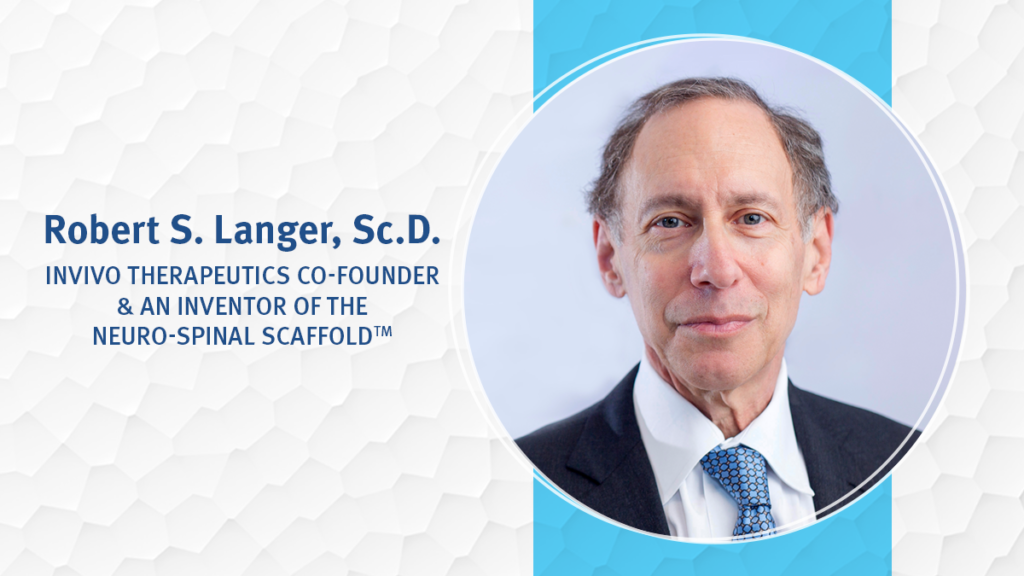‘This sounded like science fiction’
A Q&A with renowned inventor Robert S. Langer, Sc.D.
Robert S. Langer is one of the most prolific inventors and company founders in the biotech industry.
A chemical engineer by training, Dr. Langer has invented the technologies behind more than 1,360 issued and pending patents worldwide; those discoveries have been licensed or sub-licensed to more than 400 biopharma, chemical and medical device companies.
Dr. Langer is one of 12 Institute Professors at the Massachusetts Institute of Technology – the highest honor that can be awarded to a faculty member at MIT. He has received hundreds of major awards, including the National Medal of Science. Dr. Langer has served as both the chair and a member of the highest advisory board to the U.S. Food and Drug Administration.

A pioneer in the field of tissue engineering, Dr. Langer developed Neuro-Spinal ScaffoldTM to promote regeneration of nerve cells in injured spinal cords. He then co-founded InVivo Therapeutics to advance the scaffold through clinical testing. Dr. Langer also sits on InVivo’s Scientific Advisory Board.
We asked Dr. Langer about the discoveries that led to the scaffold’s development and his vision for building on the device in the future.
You are widely regarded as one of the founders of tissue engineering and regenerative medicine. What was your inspiration for resorbable polymers as surgically implanted therapies?
I’ve always been interested in the possibility of using biomaterials to solve challenging medical and surgical problems. My goal has been to leverage innovation in this field to make the biggest impact possible.
In the early 1980s, a friend (Jay Vacanti) and I had the idea of creating 3D organs from synthetic polymers to help keep babies alive while waiting for liver transplants. From my early work, I became fascinated with polymers and their potential to address a wide range of medical problems. Initially our target was the liver, but from there, we began to explore many other potential applications. We could use the polymers to help support other organs, muscle tissue and even blood vessels. Some polymers could even be used as artificial skin to help burn victims heal.
Along the way, we hit upon the idea that perhaps the right polymers could become a scaffold to bridge the cavity that develops in the spine shortly after a spinal cord injury. Neurons can’t transmit signals across that cavity, which is why patients with this type of injury become paralyzed: The signals from their brain cannot reach their arms and legs. We were interested in whether we could design a polymer that would encourage cells to grow in that cavity – and ultimately, remodel the tissue in a way that might preserve the spinal cord’s ability to transmit at least some signals from the brain. That idea became InVivo’s Neural Spinal Scaffold.
In some ways the inspiration behind our 3D scaffold structures was drawn from seaweed– we designed our polymer system based on the porous interweaving patterns you see in seaweed.
I’ve always been interested in the possibility of using biomaterials to solve challenging medical and surgical problems. My goal has been to leverage innovation in this field to make the biggest impact possible.
Why are scaffolds so well suited for the treatment of spinal cord injuries?
The scaffold is designed to provide the structural stability necessary to allow repair to take place. Basically, we hope it will give the body the jump start it needs. Once the scaffold has done its job, we expect it will be safely resorbed into the body.
The Neuro-Spinal Scaffold consists of two biocompatible polymers: PLGA (Polylactic-co-glycolic acid) provides the support and PLL (Poly-L-Lysine) promotes cellular attachment. Together these two polymers form a strong and highly porous structure that is conducive to cellular attachment and neurite outgrowth.
The original idea for the scaffold was to be a ‘bridge’ you could implant within the injured site to help cells repave the damaged spinal cord area. Our thinking was that it would close the gap like a band-aid and promote cellular regrowth. And it did perform better than control surgery without a scaffold; in animal models, we saw less scar tissue and less open space around the injury site in those treated with the scaffold.
What are potential future applications for polymers and scaffolds in the spinal cord injury field?
There is a lot of room for innovation in the spinal cord injury field. We have been investigating applying stem cells to the scaffold before it’s implanted in the patient, for instance. In preclinical studies, we are beginning to see that adding stem cells in this manner may aid in the development of certain nerve connections.
We also hope to investigate applying certain enzymes to the scaffold; we believe they may help remove scar tissue which could enable more direct access for growth factors to repair damaged nerves to help with limb mobility. We could even add controlled-release growth factors to the scaffold. We’re excited to explore these opportunities for both acute and chronic spinal cord injury.
In general, the whole area of tissue engineering is a great opportunity for biomedical innovation, as there are so many conditions that a drug alone won’t help. To a lot of people who reviewed our grant applications in 1980, this sounded like science fiction — but we have come a long way toward making it a reality in 2020.